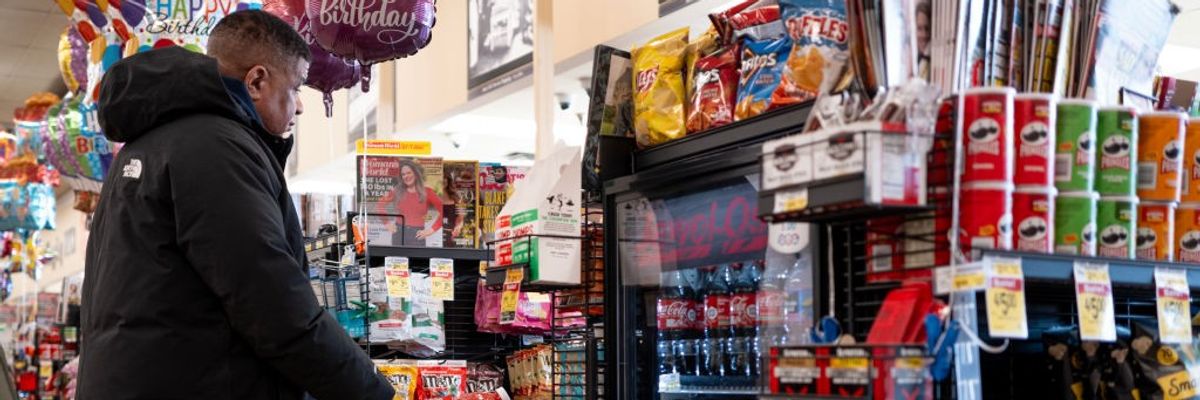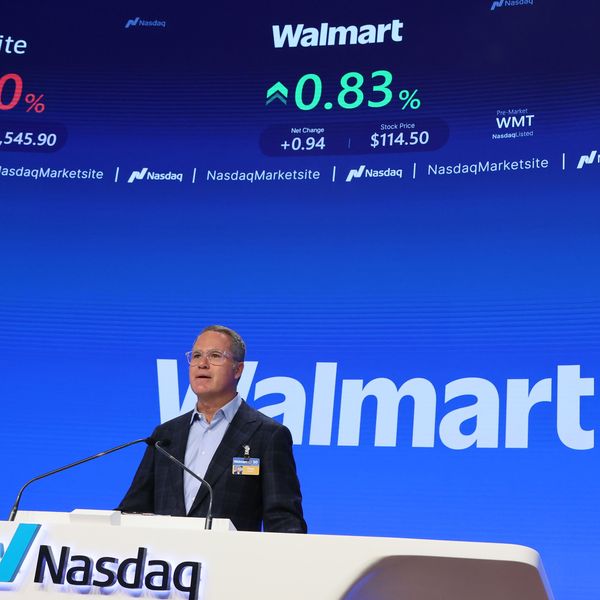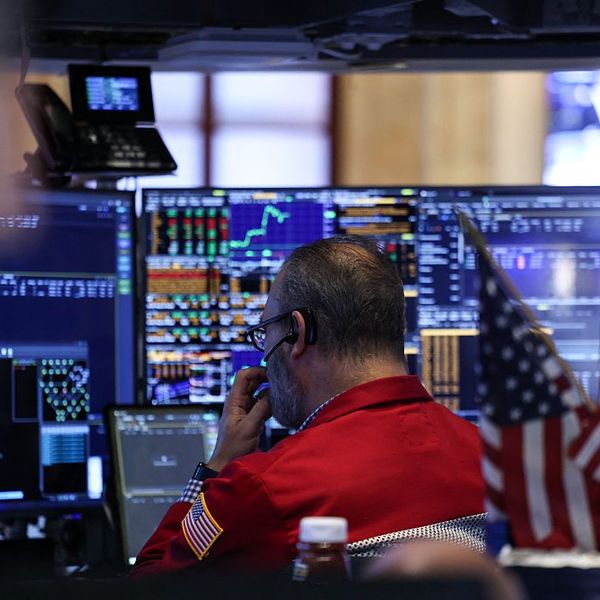
A customer prepares to check out at a grocery store on January 15, 2025 in Chicago, Illinois.
Working-Class Americans Are Hurting—And Traditional Statistics Aren't Showing How Much
Recent data show the costs of groceries, healthcare, and electricity have all been rising faster than overall inflation.
With the rising cost of groceries, housing, healthcare, and other essentials a central issue facing communities across the United States due to the Republican agenda, one expert believes that commonly cited economic statistics aren’t capturing the depth of working families' struggles.
Gene Ludwig, former US comptroller of the currency under President Bill Clinton, is arguing that the Consumer Price Index (CPI) no longer delivers an accurate portrait of families' hardships because it does not focus enough on the core costs that impact working people on a daily basis.
As reported by Bloomberg on Monday, Ludwig believes the CPI tracks too many goods that are either luxury purchases or are only bought sporadically. A relevant measure of inflation, he told the outlet, should primarily include goods that are essential to living, such as groceries, housing, healthcare, and energy.
Ludwig and his colleagues at the Ludwig Institute for Shared Economic Prosperity have developed their own measurement called True Living Cost (TLC), which focuses on core household needs and excludes items such as plane tickets and golf carts that are included in the CPI formula.
Prices as measured by the TLC have grown 1.3 times faster than prices as measured by the traditional CPI over the last 24 years, which may explain why US consumer sentiment has remained low even during times when the unemployment rate and the rate of inflation have been falling.
The biggest gap between TLC and CPI has been in measuring the cost of healthcare, as TLC shows that the rise in costs has been much more severe than what has been shown in traditional inflation statistics.
"In the CPI, medical care mostly measures reimbursements to providers made by private insurers and Medicare, in addition to patient payments, but the TLC tracks only households' out-of-pocket expenses and contributions to medical and dental plans," explained Bloomberg. "The CPI shows medical costs have doubled since 2001, whereas the TLC shows they’ve almost tripled, largely from a massive rise in premiums."
Ludwig's arguments about traditional inflation measures not capturing the true state of Americans' fiscal stability were backed up by a report from The Washington Post on Sunday, which examined recent trends in housing, healthcare, food, and utility prices, and found that all of them have been rising faster than the top-line rate of inflation as measured by CPI.
The Post cited the most recent CPI data showing that natural gas bills have risen by nearly 14% over the last year, while electricity bills have surged by 6% over the same period. Grocery prices also registered their biggest spike since 2022, thanks in part to US President Donald Trump's tariffs on imported staple foods such as coffee and bananas.
Mark Zandi, chief economist at Moody’s Analytics, told the Post that these costs are not mere luxuries that people can sacrifice until their financial situation improves.
"It’s not that they have a choice," he said. "We’re talking about things that people must buy. They have to live somewhere... They have to heat their homes. They need lights."
A recent CNN report focused on factors related to the most recent spike in grocery prices and found that Trump's policies were to blame for at least two of them.
Most directly, CNN found that the tariffs on imported foods resulted in higher prices at the grocery store checkout line. Additionally, the Trump administration's crackdown on undocumented farm workers has harmed the supply of food that's grown domestically, which has also resulted in price increases.
And finally, CNN reported that droughts exacerbated by human-caused climate change have also hurt supplies of beef and oranges, which have led to further price squeezes.
David Ortega, a food economist at Michigan State University, told CNN that Trump's current policy agenda "is more likely to increase the price of food" than make it more affordable.
Given the rising cost of staple groceries, many Americans have been turning to cheaper alternatives. According to The New York Times, sales of Hamburger Helper have grown by 14.5% over the last year, which is a sign that shoppers are bypassing more expensive cooking ingredients in favor of low-cost, easy-to-make meals.
Additionally, the Times report found that sales of foods that are "commonly purchased by consumers when financial times get tough—such as rice, canned meats such as tuna, and boxes of macaroni and cheese—have also been strong.
Sally Lyons Wyatt, global consumer packaged goods and food service industry adviser at research firm Circana, told the Times that US shoppers right now seem to be "looking for foods that fill them up for the least amount of money."
An Urgent Message From Our Co-Founder
Dear Common Dreams reader, The U.S. is on a fast track to authoritarianism like nothing I've ever seen. Meanwhile, corporate news outlets are utterly capitulating to Trump, twisting their coverage to avoid drawing his ire while lining up to stuff cash in his pockets. That's why I believe that Common Dreams is doing the best and most consequential reporting that we've ever done. Our small but mighty team is a progressive reporting powerhouse, covering the news every day that the corporate media never will. Our mission has always been simple: To inform. To inspire. And to ignite change for the common good. Now here's the key piece that I want all our readers to understand: None of this would be possible without your financial support. That's not just some fundraising cliche. It's the absolute and literal truth. We don't accept corporate advertising and never will. We don't have a paywall because we don't think people should be blocked from critical news based on their ability to pay. Everything we do is funded by the donations of readers like you. Will you donate now to help power the nonprofit, independent reporting of Common Dreams? Thank you for being a vital member of our community. Together, we can keep independent journalism alive when it’s needed most. - Craig Brown, Co-founder |
With the rising cost of groceries, housing, healthcare, and other essentials a central issue facing communities across the United States due to the Republican agenda, one expert believes that commonly cited economic statistics aren’t capturing the depth of working families' struggles.
Gene Ludwig, former US comptroller of the currency under President Bill Clinton, is arguing that the Consumer Price Index (CPI) no longer delivers an accurate portrait of families' hardships because it does not focus enough on the core costs that impact working people on a daily basis.
As reported by Bloomberg on Monday, Ludwig believes the CPI tracks too many goods that are either luxury purchases or are only bought sporadically. A relevant measure of inflation, he told the outlet, should primarily include goods that are essential to living, such as groceries, housing, healthcare, and energy.
Ludwig and his colleagues at the Ludwig Institute for Shared Economic Prosperity have developed their own measurement called True Living Cost (TLC), which focuses on core household needs and excludes items such as plane tickets and golf carts that are included in the CPI formula.
Prices as measured by the TLC have grown 1.3 times faster than prices as measured by the traditional CPI over the last 24 years, which may explain why US consumer sentiment has remained low even during times when the unemployment rate and the rate of inflation have been falling.
The biggest gap between TLC and CPI has been in measuring the cost of healthcare, as TLC shows that the rise in costs has been much more severe than what has been shown in traditional inflation statistics.
"In the CPI, medical care mostly measures reimbursements to providers made by private insurers and Medicare, in addition to patient payments, but the TLC tracks only households' out-of-pocket expenses and contributions to medical and dental plans," explained Bloomberg. "The CPI shows medical costs have doubled since 2001, whereas the TLC shows they’ve almost tripled, largely from a massive rise in premiums."
Ludwig's arguments about traditional inflation measures not capturing the true state of Americans' fiscal stability were backed up by a report from The Washington Post on Sunday, which examined recent trends in housing, healthcare, food, and utility prices, and found that all of them have been rising faster than the top-line rate of inflation as measured by CPI.
The Post cited the most recent CPI data showing that natural gas bills have risen by nearly 14% over the last year, while electricity bills have surged by 6% over the same period. Grocery prices also registered their biggest spike since 2022, thanks in part to US President Donald Trump's tariffs on imported staple foods such as coffee and bananas.
Mark Zandi, chief economist at Moody’s Analytics, told the Post that these costs are not mere luxuries that people can sacrifice until their financial situation improves.
"It’s not that they have a choice," he said. "We’re talking about things that people must buy. They have to live somewhere... They have to heat their homes. They need lights."
A recent CNN report focused on factors related to the most recent spike in grocery prices and found that Trump's policies were to blame for at least two of them.
Most directly, CNN found that the tariffs on imported foods resulted in higher prices at the grocery store checkout line. Additionally, the Trump administration's crackdown on undocumented farm workers has harmed the supply of food that's grown domestically, which has also resulted in price increases.
And finally, CNN reported that droughts exacerbated by human-caused climate change have also hurt supplies of beef and oranges, which have led to further price squeezes.
David Ortega, a food economist at Michigan State University, told CNN that Trump's current policy agenda "is more likely to increase the price of food" than make it more affordable.
Given the rising cost of staple groceries, many Americans have been turning to cheaper alternatives. According to The New York Times, sales of Hamburger Helper have grown by 14.5% over the last year, which is a sign that shoppers are bypassing more expensive cooking ingredients in favor of low-cost, easy-to-make meals.
Additionally, the Times report found that sales of foods that are "commonly purchased by consumers when financial times get tough—such as rice, canned meats such as tuna, and boxes of macaroni and cheese—have also been strong.
Sally Lyons Wyatt, global consumer packaged goods and food service industry adviser at research firm Circana, told the Times that US shoppers right now seem to be "looking for foods that fill them up for the least amount of money."
- Fed Officials Warn Trump is Steering Our Economy Toward Disaster, Stagflation ›
- The Commodification of the Commons Is Killing Us All ›
- In the Ongoing Billionaire Heist, Schumer and Fetterman Are Driving the Getaway Car ›
- 'Another Trump Lie': Despite Campaign Pledges, Electricity Costs Up $100 Per Family | Common Dreams ›
- Opinion | Trump Is Lying About Grocery Prices; What Else? | Common Dreams ›
With the rising cost of groceries, housing, healthcare, and other essentials a central issue facing communities across the United States due to the Republican agenda, one expert believes that commonly cited economic statistics aren’t capturing the depth of working families' struggles.
Gene Ludwig, former US comptroller of the currency under President Bill Clinton, is arguing that the Consumer Price Index (CPI) no longer delivers an accurate portrait of families' hardships because it does not focus enough on the core costs that impact working people on a daily basis.
As reported by Bloomberg on Monday, Ludwig believes the CPI tracks too many goods that are either luxury purchases or are only bought sporadically. A relevant measure of inflation, he told the outlet, should primarily include goods that are essential to living, such as groceries, housing, healthcare, and energy.
Ludwig and his colleagues at the Ludwig Institute for Shared Economic Prosperity have developed their own measurement called True Living Cost (TLC), which focuses on core household needs and excludes items such as plane tickets and golf carts that are included in the CPI formula.
Prices as measured by the TLC have grown 1.3 times faster than prices as measured by the traditional CPI over the last 24 years, which may explain why US consumer sentiment has remained low even during times when the unemployment rate and the rate of inflation have been falling.
The biggest gap between TLC and CPI has been in measuring the cost of healthcare, as TLC shows that the rise in costs has been much more severe than what has been shown in traditional inflation statistics.
"In the CPI, medical care mostly measures reimbursements to providers made by private insurers and Medicare, in addition to patient payments, but the TLC tracks only households' out-of-pocket expenses and contributions to medical and dental plans," explained Bloomberg. "The CPI shows medical costs have doubled since 2001, whereas the TLC shows they’ve almost tripled, largely from a massive rise in premiums."
Ludwig's arguments about traditional inflation measures not capturing the true state of Americans' fiscal stability were backed up by a report from The Washington Post on Sunday, which examined recent trends in housing, healthcare, food, and utility prices, and found that all of them have been rising faster than the top-line rate of inflation as measured by CPI.
The Post cited the most recent CPI data showing that natural gas bills have risen by nearly 14% over the last year, while electricity bills have surged by 6% over the same period. Grocery prices also registered their biggest spike since 2022, thanks in part to US President Donald Trump's tariffs on imported staple foods such as coffee and bananas.
Mark Zandi, chief economist at Moody’s Analytics, told the Post that these costs are not mere luxuries that people can sacrifice until their financial situation improves.
"It’s not that they have a choice," he said. "We’re talking about things that people must buy. They have to live somewhere... They have to heat their homes. They need lights."
A recent CNN report focused on factors related to the most recent spike in grocery prices and found that Trump's policies were to blame for at least two of them.
Most directly, CNN found that the tariffs on imported foods resulted in higher prices at the grocery store checkout line. Additionally, the Trump administration's crackdown on undocumented farm workers has harmed the supply of food that's grown domestically, which has also resulted in price increases.
And finally, CNN reported that droughts exacerbated by human-caused climate change have also hurt supplies of beef and oranges, which have led to further price squeezes.
David Ortega, a food economist at Michigan State University, told CNN that Trump's current policy agenda "is more likely to increase the price of food" than make it more affordable.
Given the rising cost of staple groceries, many Americans have been turning to cheaper alternatives. According to The New York Times, sales of Hamburger Helper have grown by 14.5% over the last year, which is a sign that shoppers are bypassing more expensive cooking ingredients in favor of low-cost, easy-to-make meals.
Additionally, the Times report found that sales of foods that are "commonly purchased by consumers when financial times get tough—such as rice, canned meats such as tuna, and boxes of macaroni and cheese—have also been strong.
Sally Lyons Wyatt, global consumer packaged goods and food service industry adviser at research firm Circana, told the Times that US shoppers right now seem to be "looking for foods that fill them up for the least amount of money."
- Fed Officials Warn Trump is Steering Our Economy Toward Disaster, Stagflation ›
- The Commodification of the Commons Is Killing Us All ›
- In the Ongoing Billionaire Heist, Schumer and Fetterman Are Driving the Getaway Car ›
- 'Another Trump Lie': Despite Campaign Pledges, Electricity Costs Up $100 Per Family | Common Dreams ›
- Opinion | Trump Is Lying About Grocery Prices; What Else? | Common Dreams ›

